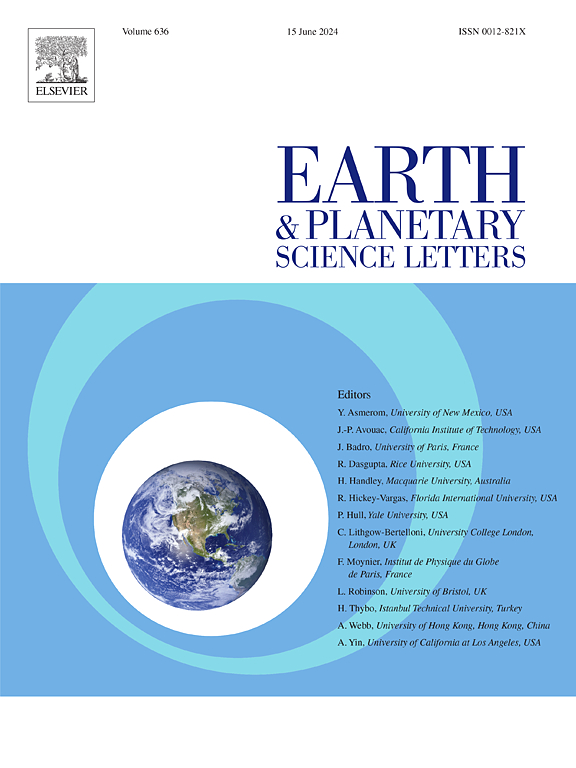利用保存完好的腕足动物贝壳的锂同位素研究二叠纪大陆风化强度的制约因素
IF 4.8
1区 地球科学
Q1 GEOCHEMISTRY & GEOPHYSICS
引用次数: 0
摘要
海洋碳酸盐中的锂(δ7Li)同位素组成是追踪地质历史中大陆风化强度的有力手段,有助于我们了解地球是如何以及为什么仍然适合居住的。然而,古碳酸盐中的δ7Li值可能会受到原生碳酸盐矿物学(如文石、高镁方解石、低镁方解石)和沉积后成岩作用等因素的影响,从而改变其主要信号。与当代海水相比,现代有节腕足类贝壳显示出恒定的 δ7Li 偏移,这表明化石腕足类贝壳由于其成因抗性低镁方解石成分,可以作为这种地球化学替代物的可靠档案。尽管存在这种潜力,但很少有研究对这一主题进行探讨。在本研究中,我们分析和比较了华南地区二叠纪地层中腕足动物化石贝壳及其所包围的碳酸盐岩的地球化学组成,以研究腕足动物贝壳是否能可靠地保存古海水的δ7Li值,如果能,则可获得二叠纪大陆风化机制变化的新的制约因素。我们使用了几种成岩筛选方法,包括扫描电子显微镜、阴极发光显微镜和元素浓度来检测潜在的成岩蚀变。结果表明,49 个贝壳中有 32 个保留了原始的 δ7Li 值。值得注意的是,我们观察到腕足动物贝壳与其所包围的碳酸盐岩之间的δ7Li偏移量在所研究的断面上有所不同,这可能是由于大块碳酸盐岩的成岩蚀变所致。利用保存完好的腕足动物贝壳的 δ7Li 值,我们重建了二叠纪海水的 δ7Li 变化。我们确定了三个截然不同的区间:(1) 阿赛尔期和萨克马期的极低 δ7Lisw 值(低至 6.7 ± 2.9‰,n = 12,1sd);(2) 高 δ7Lisw 值(32.6 ± 4.5‰,n = 3,1sd);(3)从卡皮坦期到长兴期,δ7Lisw 值相对较低(13.6 ± 3.9‰,n = 14,1sd)。二叠纪海水δ7Li值的这些重大变化表明,二叠纪大陆风化机制发生了巨大变化,这可能与重大气候变化有关,如晚古生代冰期的结束以及与大型火成岩带的形成有关的气候变暖。本文章由计算机程序翻译,如有差异,请以英文原文为准。
Constraints on the continental weathering intensity through the Permian using lithium isotopes of well-preserved brachiopod shells
Lithium isotopic compositions (δ7Li) in marine carbonates provide a powerful means to track continental weathering intensity through geological history and promote our understanding of how and why Earth remained habitable. However, δ7Li values in ancient carbonates can be affected by factors such as primary carbonate mineralogy (e.g., aragonite, high-Mg calcite, low-Mg calcite) and post-depositional diagenesis, which may alter their primary signals. Modern articulate brachiopod shells have shown a constant δ7Li offset compared to contemporary seawater, suggesting that fossil brachiopod shells could serve as robust archives for this geochemical proxy due to their diagenetically resistant low-Mg calcite composition. Despite this potential, few studies have explored this topic. In this study, we analyze and compare the geochemical compositions of fossil brachiopod shells and their enclosing carbonate rocks from Permian strata in South China to investigate whether brachiopod shells can reliably preserve the δ7Li values of ancient seawater and, if they do, to obtain new constraints on changes in the continental weathering regimes through the Permian. We used several diagenetic screening methods, including scanning electron microscopy, cathodoluminescence microscopy, and elemental concentrations to detect potential diagenetic alteration. Our results indicate that 32 out of 49 shells preserve primary δ7Li values. Notably, we observed that δ7Li offsets between brachiopod shells and their enclosing carbonate rocks vary across the studied sections, likely due to diagenetic alteration of the bulk carbonates. Using the δ7Li values from well-preserved brachiopod shells, we reconstructed δ7Li variations of Permian seawater. We identified three distinct intervals: (1) extremely low δ7Lisw values (as low as 6.7 ± 2.9‰, n = 12, 1sd) during the Asselian and Sakmarian stages, (2) high δ7Lisw values (32.6 ± 4.5‰, n = 3, 1sd) similar to modern seawater during the Kungurian stage, and (3) relatively low δ7Lisw values (13.6 ± 3.9‰, n = 14, 1sd) from the Capitanian to the Changhsingian stages. These significant changes in δ7Li values of Permian seawater indicate dramatic changes in continental weathering regimes during the Permian, possibly linked to major climate changes, such as the termination of the Late Paleozoic Ice Age and warming associated with the emplacement of the large igneous provinces.
求助全文
通过发布文献求助,成功后即可免费获取论文全文。
去求助
来源期刊

Earth and Planetary Science Letters
地学-地球化学与地球物理
CiteScore
10.30
自引率
5.70%
发文量
475
审稿时长
2.8 months
期刊介绍:
Earth and Planetary Science Letters (EPSL) is a leading journal for researchers across the entire Earth and planetary sciences community. It publishes concise, exciting, high-impact articles ("Letters") of broad interest. Its focus is on physical and chemical processes, the evolution and general properties of the Earth and planets - from their deep interiors to their atmospheres. EPSL also includes a Frontiers section, featuring invited high-profile synthesis articles by leading experts on timely topics to bring cutting-edge research to the wider community.
 求助内容:
求助内容: 应助结果提醒方式:
应助结果提醒方式:


